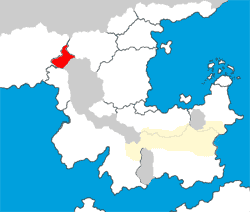Country Info: the Steinlands
 |
| Terminology: | Steinlander (STINE-land-err) people, one Steinlander, many Steinlanders |
The Steinlands were part of the Zdunarovan empire for several centuries, though culturally distinct from the capital region. These differences were exacerbated in 1004 when the Steinlander dukes and duchesses rebelled against their overlords, not wishing to participate in the Czarina's war with Bilgosh.
Eight duchies declared their oaths of fealty to the Czarina invalid, and fought a bitter war to win their independence. While the Zdunarovan army was drained and demoralized from fighting the Bilgoshmen, it also outnumbered the Steinlanders. The Steinlands' main resource was money, since it lies in fertile grounds and on good trade routes, and the Steinlander dukes incurred deep debts to hire mercenaries to combat the Imperial army.
The Czarina's envoys met with the rebel dukes, and agreed on January 18, 1008 to recognize the independence of the seven duchies outside of Imperial control. (One rebel duchy, Gravenia, had been recaptured by the Zdunarovans and remained a Zdunarovan possession.)
The future of the region is unclear. The seven dukes recognize the need for alliance to guard their hard-won independence, but at the same time, many of them value their newfound sovereignty strongly and would be reluctant to elevate one of their number as monarch. The Steinlands are thus not quite a country, but more than just a region.
The seven duchies
- Alsoria
- Dorschelia
- Elsitz, ruled by Duke Karl
- Launenberg
- Parmen
- Silbermark, ruled by Duchess Wilhelmina
- Toldavia, ruled by Duke Mikhail
Nobles
Seven Dukes, each of whom is the liege of a number of Counts and Barons.
